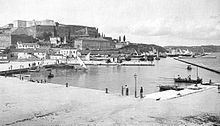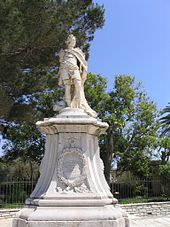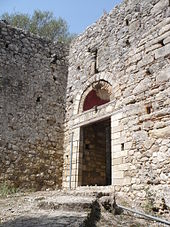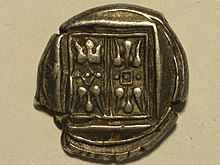Corfu
![]()
The title of this article is ambiguous. For other meanings, see Corfu (disambiguation).
Corfu (Modern Greek Κέρκυρα Kérkyra [ˈkʲɛrkʲira] (f. sg.); Ancient Greek Κόρκυρα Kórkyra; Albanian Korfuz/Korfuzi) is the second largest of the Ionian Islands, covering 585.312 km², and the seventh largest in Greece. It lies southeast of the Italian "boot heel" and, separated by the Strait of Corfu, approaches the Albanian coast to within two kilometres to the north. Due to its vegetation, caused by a climate balanced for Mediterranean conditions with Mediterranean, sub-Mediterranean and Central European elements, the island is also called "the green island". It is one of the most prosperous regions of Greece.
The island of Corfu is divided into three municipalities, to which the Diapontic Islands also belong as municipal districts. These municipalities and the municipality of Paxi together form the regional district of Kerkyra, which had the status of a prefecture until the implementation of the Kallikratis programme. The capital is the town of the same name, Corfu or Kerkyra. The islanders are called Corfiotes.
Geography
Corfu stretches for about 60 kilometres off the Albanian and Greek west coasts in the Ionian Sea, about 75 kilometres southeast of the Strait of Otranto. The narrowest part of the Corfu Strait between the northeast of the island and the Albanian mainland is about two kilometres wide (west of Ksamil). The island is characterized by hills and mountains, two mountain ranges divide the island: in the north the chain of Pantokrator (up to 911 m above sea level) and in the middle the Agii Deka with 576 m height.
Climate table
| Corfu (City) | ||||||||||||||||||||||||||||||||||||||||||||||||
| Climate diagram | ||||||||||||||||||||||||||||||||||||||||||||||||
| ||||||||||||||||||||||||||||||||||||||||||||||||
| Monthly average temperatures and precipitation for Corfu (City)
Source: wetterkontor.de | ||||||||||||||||||||||||||||||||||||||||||||||||||||||||||||||||||||||||||||||||||||||||||||||||||||||||||||||||||||||||||||||||||||||||||||||||||||||||||||||||||||||||||||||||||||||||||||||||||||||||||||||||||||||||||||||||||||||||||||||||||||||||||||||||||||||||||||||||||||||||||
flora and fauna
Corfu has a microclimate that favors the growth of wildflowers, there are 36 species of orchids on the island. About four percent of Corfu's animal and plant species are endemic. The wetlands and lagoons in the southwest of the island are an important habitat for birds, over 150 species have been counted in the Corrision lagoon area alone.
Ubiquitous are the approximately 4 million olive trees on Corfu, which have their origins in the 16th century when the Venetians encouraged planting. Other trees include oaks, elms and cypresses, as well as the aspen, which blooms purple in spring. In 1846, the dwarf orange tree Citrus japonica was introduced to Corfu. Koum Kouat from Corfu has been a Corfiot liqueur speciality ever since.
About 65% of the island's land is used for agriculture, 55% by olive trees, the rest is mainly vineyards and citrus fruit.
Structure
Before the municipal reform under the Kapodistrias programme, the island consisted of 100 often small municipalities. In 1997, these municipalities were merged into twelve municipalities. The 2010 administrative reform united these municipalities with the three island municipalities of the Diapontic Islands into a single municipality of Kerkyra on 1 January 2011. The twelve municipalities of 1997 had the status of a municipal district, the old 100 municipalities had their own local representations depending on their number of inhabitants as municipal districts (Ez. Dimotiki Kinotita, from 1000 inhabitants) or local communities (Topiki Kinotita). A revision of the administrative reform was implemented in 2019, dividing the island into three municipalities. The three dipontic islands of Erikoussa, Mathraki and Othoni were assigned as municipal districts to the municipality of Kendriki Kerkyra ke Diapondia Nisia.
| Community | Greek name | Code | Area km² | Inhabitants 2011 | District | Location |
| Kendriki Kerkyra ke Diapondia Nisia | Κεντρική Κέρκυρα και Διαπόντια Νησιά | 3201 | 259,504 | 68.558 | Kerkyra, Achillio, Erikoussa, Feakes, Mathraki, Othoni, Paleokastritsa, Parelii |
|
| Voria Kerkyra | Βόρεια Κέρκυρα | 3203 | 205,325 | 17.832 | Agios Georgios, Esperies, Thinali, Kassiopi |
|
| Notia Kerkyra | Νότια Κέρκυρα | 3204 | 145,026 | 15.681 | Korissia, Lefkimmi, Melitia |
|
| Total | 592,877 | 100.854 | ||||
History
Prehistory
Hunter-gatherers settled the island perhaps as early as 750,000 years ago. In any case, a chopper was discovered near Gardiki in the southwest near the Korission lagoon in a layer that was dated accordingly. Neanderthals also visited the island, which at that time was only a maximum of 12 km from the mainland.
Besides Gardiki, an important prehistoric site is the Upper Paleolithic Agios Mattheos in the southwest, where 870 flint artefacts were discovered in 1966 under a rock overhang about 18 m deep. They show similarities with the site of Kastritsa in Epiros, which is about the same age. Eleven Levallois-Moustérian sites were already known in the late 1960s, but their dating is disputed. The artefacts on the small island of Diaplo, which were discovered on the beach in 1965, indicate contacts with the sites on the Gargano in Italy.
Due to the rising sea level, Corfu was separated from the mainland again between 10,000 and 8000 BC. In the Neolithic period, from 6400 to 6300 BC, according to other authors already around 6500 BC, farmers and shepherds settled on the island, as proved at the Sidari site, which is sterile in the post-Neolithic layers.
In the Bronze Age, the island was again settled; an important archaeological site is Afiona. The finds on Corfu show a close relationship to contemporary artefacts from Macedonia and Epirus; in addition to Afiona, western contacts could also be proven at the sites of Stalakto, Ermones, Kefali and Sidari. Corfu is mentioned as early as 1200 BC on a Linear B tablet from the palace of Nestor at Pylos, which refers to a "man from Korkyra" (ko-ro-ku-ra-i-jo). Corfu was not part of the Mycenaeanculture. However, there were trade relations during the Late Bronze Age, as evidenced by finds of Mycenaean pottery at various sites on the island. Nevertheless, the Bronze Age culture of Corfu has a distinctly local character.
Mythology
Corfu was equated by some ancient authors with Scheria, the land of the Phaiaks from Greek mythology; however, this thesis was already disputed in antiquity, since Homer emphasizes that Scheria was very far away, at the end of the world. In the Odyssey, the land of the Phaiaks is Odysseus' last stop before returning home to Ithaca. According to the Argonautika of Apollonios of Rhodes, Medea and Iason, on their flight from Colchis, also find shelter among the Phaiaks, who in this version live on the island of Drepane, and which, according to his account, corresponds to Corfu. They married there, according to the legend, in the grotto of Makris, whose name the island also bore. The Greek name Kerkyra was given to the island, according to the legend, by the nymph Gorgyra (also Kerkyra), who was brought to the island by the sea god Poseidon. Phaiax, the child of this connection, was therefore the ancestor of the Phaiaks.
Ancient
Greek settlers from Eretria founded a first colony in the 8th century BC. Due to its advantageous location on the Strait of Otranto, Kerkyra controlled access to the west and to the coasts of the AdriaticSea. In 734 BC, the oikist Chersikrates, who was from Corinth and left the city due to internal unrest, expelled the Eretrian colonists with a force, who then settled in Thrace and founded the city of Methone.
Kerkyra rose very quickly to a naval power. In 664 BC, it defeated the mother city of Corinth in what was, according to Thucydides, the first naval battle in Greece, breaking away from their domination. In 480 BC Corfu provided the second largest fleet of the Greeks, 60 ships, but did not actively participate in the war against the Persians. The historian Thucydides sees the conflict between Corfu and Corinth over the city of Epidamnos and the protective alliance that the Athenians granted Corfu as one of the occasions for the outbreak of the Peloponnesian War. During this conflict, in 427, a bloody stasis (civil war) occurred in the polis of Kerkyra, which Thucydides later described very vividly. In the 4th century BC, the Corfiotes extended their influence to the mainland. For a time they occupied Butrint, an important polis of the Chaonians.
In the Hellenistic period (from 300 BC), Corfu's independence was threatened. The island was raided by adventurers from Syracuse and Macedonian kings, followed by Illyrian pirates, used the island for raids against Roman merchant ships.
As a result of the Roman war against the Illyrian queen Teuta, Corfu became the first Roman province in Greece. Later Corfu was part of the Roman province of Macedonia, and in Augustan times the island was added to the province of Epiros.
In the 3rd century, Jason and Sosipater introduced Corfu to Christianity.
Medieval
From 395 Corfu belonged to the Eastern Roman Empire. The island was conquered by the Saracens and in the 11th century by the Norman Duke Robert Guiscard.
As a result of the 4th Crusade, Corfu came under the rule of the despot of Epiros after 1204. As a dowry of Helen of Epirus, the island had come into the possession of Manfred of Sicily in 1258. Since that time, numerous fiefs were issued on the island to Frankish nobles. After King Manfred had fallen in the Battle of Benevento (1266) against Charles I of Anjou and his wife Helena had been taken prisoner, the latter's grand admiral and administrator of the estates of Helena's dowry, Philip Chinard (* c. 1205; † 1266), who had remained on Corfu, took refuge with Charles's father-in-law Michael II. Komnenos Dukas Angelos, despot of Epirus, as he realized that as Manfred's follower he could only rely on his own forces and feared the loss of his fiefs (Corfu, Buthroton, Valona, Dyrrachium). This fear led him to seek an alliance with the despot of Epirus, who gave him his sister-in-law Maria Petralipha as a bride, gave Helena's dowry, but had him assassinated shortly afterwards (before October 1, 1266). After Philip Chinard's murder, the crusader Garnier l'Aleman (Philip Chinard's vicar) took over the administration of Corfu. Charles contacted Garnier l'Aleman and offered him land in the Kingdom of Sicily of an annual value of 100 ounces, or 1000 ounces of gold in cash, for "the whole island of Corfu with castles with country houses and all the lands of the Usher". In fact, Garnier gave the island to Charles of Anjou in March 1267, who appointed him his captain-general on March 20, 1267, and gradually conquered the despotate of Epirus from 1268. Charles' promise in favour of Garnier could not be carried out because of his death. From a document dated May 1272, it appears that Charles allotted in cash to the son of the deceased Garnier, Aimone Aleman, the promised land of the above annual value of 100 ounces or 1000 ounces of gold.
In 1271 Giovanni Clariaco became the first Vicar of Corfu: "[...] et confirmazione Iohannes de Clariaco tunc vicarii nostri in ipsa insula [...]" Under Angevin rule, the feudal system of the Western European type came into full formation. Charles introduced the same civil and military offices that existed in the kingdom; from captain and treasurer (camerario) to portolan. In 1272 Corfu became a separate administrative unit under the second vicar Giordano Sanfelice, to which the castle of Buthroton and Subuto (or Subito) on the Albanian mainland were also beaten. In 1294 the island was transferred by Charles II of Anjou to his son Philip, Prince of Taranto, who in 1330 (or shortly afterwards) appointed Guglielmo II Tocco governor of Corfu. In 1352 Robert of Taranto took control of Corfu. Under Charles III, Corfu fell to the Venetians in 1383. Besides the capital, Angelokastro and Gardiki were the most important fortresses of the Venetian colonies. Cultural influences of the western feudal lords combined with the local Greek Orthodox traditions to form an independent culture.
16th to 19th century
From the 16th to the 18th century, Corfu's history was marked by conflicts with the OttomanEmpire, which ruled the Greek mainland and repeatedly tried to conquer and hold the Ionian Islands. The Venetians (Republic of Venice) ordered the removal of the vineyards and the planting of olive trees. In 1716, the Ottoman siege of the island's capital was lifted by the Venetian army under Johann Matthias von der Schulenburg, thus finally repelling the last Turkish attempt to conquer the island.
After the end of the Republic of Venice in 1797, France (under Napoleon) took possession of the Ionian Islands and Corfu as the Department of Corcyre. For a short time, from 1798 to 1807, Corfu was a Russian protectorate. This was followed by another French period until 1814.
In 1815 (Congress of Vienna) Corfu became part of the Republic of the Ionian Islands under British protectorate. During the British period, much of the modern infrastructure was built, such as the 700 km long road network, which is one of the densest in Greece. On May 21, 1864, Corfu was ceded to the Kingdom of Greece, but was declared permanently neutral by a treaty, with France as the signatory power.
20th century
During the First World War, Corfu was the seat of the Serbian government-in-exile from 1916 to 1918. In 1917, the Declaration of Corfu on the establishment of the Yugoslav state was adopted here.
Mussolini came to power in Italy in 1922. He had great power ambitions; since the 1930s these were also directed at the Balkans. After the Corfu Incident in 1923, Italy briefly occupied Corfu. From April 7 to 12, 1939, Italy occupied Albania. In September 1939, the SecondWorld War began. When the German Empire had almost won the Western campaign in the summer of 1940, Mussolini entered the war (more details here).
On 15 October 1940, the Italian War Council in Rome decided to attack Greece without consulting the Germans. On the morning of 28 October 1940, Italian troops attacked Greek territory from Albania; the Greek-Italian War began. On 28 November 1940, an Italian squadron shelled Corfu. It was not until the German intervention in the Balkan campaign from 6 April 1941 that the war was decided in favour of the Axis powers, ending on 23 April 1941. Corfu was annexed by Italy.
In July 1943 Italy changed sides (Mussolini was arrested; Pietro Badoglio became prime minister). On September 24, 1943, parts of the 1st Mountain Division of the Wehrmacht landed on Corfu. They came from the neighboring island of Kefalonia, where they had committed war crimes. On the 25th they captured the commander of the Italian troops standing there, Colonel Luigi Lusignani. After brief negotiations, he ordered his 8,000 men to lay down their arms. Of the 280 Italian officers on the island, 28 were shot shortly after their capture, and the following day, on Hubert Lanz's orders, the remaining officers were also shot. On Lanz's orders, the bodies were "taken out to sea by ship and weighted down and dumped in several places".
Western Allied bomber units flew numerous air raids on Corfu. Corfu Town was partially destroyed in June 1944. On 11 and 15 June 1944, 1700 of Corfu's 1900 Jews were deported to Auschwitz under German control; only 122 of them survived the extermination camp. Numerous Albanians were murdered or expelled to Albania.
The Corfu Channel Incident refers to three unrelated Cold War incidents involving Royal Navy ships in the Corfu Strait in 1946.
Unlike the Ionian islands of Kefalonia, Zakynthos and Ithaca, Corfu was spared the earthquake of 12 August 1953.
As a successor to the Ionian Academy, the Ionian University was founded in 1984. In June 1994 Corfu hosted the Summit of EU Member States, where, among other things, the accession of some states to the EU was decided and signed.

The port of Corfu in 1890

Monument of Schulenburg in Corfu Town

Entrance to the fortress Gardiki

Finds in the Archaeological Museum of Corfu, 7th-3rd century BC, below the reconstruction of a child's grave from the 4th/3rd century BC.

Stater from Kerkyra, reverse, stylized double flowers in ornamental rectangles, Szaivert/Sear No. 2284

Stater from Kerkyra, cow with calf, minted ca. 450-400 B.C.
Questions and Answers
Q: Where is Corfu located?
A: Corfu is located in the Ionian Sea northwest of Greece.
Q: What is the size of Corfu?
A: The island of Corfu has a total area of 1,540 km2 (590 sq mi).
Q: How many people lived on the island of Corfu in 2001?
A: In 2001, 109,537 people lived on the island of Corfu.
Q: What is the largest city on Corfu?
A: Corfu city is the largest city on the island of Corfu.
Q: What is the ranking of Corfu among the largest Greek islands?
A: Corfu (or Kerkyra) is the seventh-largest Greek island.
Q: Why is Corfu famous?
A: Corfu is famous for its beautiful beaches, stunning landscape and rich history.
Q: What language do people speak in Corfu?
A: The official language of Corfu is Greek, however, English is also widely spoken in tourist areas.
Search within the encyclopedia


